Page 145 of 288

Fo r exa mple, the a irbag may depl oy if:
-a small child that is heavier than a typical 1
year-o ld child is on the front passe nger seat
(regardless of whether the child is in one of
the chi ld seats listed
page 168), or
- a ch ild who has outgrown child rest raints is
on the front passenger seat.
If the front passenger airbag is turned off, the
P ASS ENGER AIR B AG OFF light comes on in
the instrument cluster and stays on.
If the front passenger airbag deploys, the
Federal Standard requires the airbag to meet
the "low risk" deployment criter ia to reduce
the r isk of injury through interaction with the
airbag. "Low risk" deployment occurs in those
crashes that take place at lower decelerations
as defined in the electronic control unit
r::> page 153, PASSENGER AIR BAG OFF light.
Always remember, a chi ld seat or infant carri
er insta lled on the front seat may be struck
and knocked out of position by the rapidly in
flating passenger's airbag in a frontal colli
sion. The airbag could greatly reduce the ef
fectiveness of the child restraint and even se
riously injure the child during inflat ion.
For this reason, and because the back seat is
the safest place for children - when properly
restrained according to their age and size - we
strongly recommend that children always sit
in the back seat
r::> page 166, Child Safety .
A WARNING
A child in a rearward-facing child seat in
stalled on the front passenger seat will be
ser iously injured and can be killed if the
front airbag inflates -even with an Ad
vanced Airbag System .
- T he inflating airbag will hit the child seat
or infant carrier with great force and wi ll
smash the child seat and child against
the backrest, center armrest, door or roof.
- Always install rear-facing child seats on
the rear seat.
- If you must install a rearward facing
child seat on the front passenger seat
-
A irbag system 143
because of exceptional circumstances
and the
PAS SENGER AIR BAG OFF light
does not come on and stay on, immed i
ately install the rear-fac ing child seat in a
rear seat ing pos ition and have the airbag
system inspected by your A udi dealer.
- Forward-facing child seats installed on the front passenger's seat may interfere
with the dep loyment of the a irbag and
cause serious persona l injury to the
child.
A WARNING
If, in except iona l circumstances, you must
install a forward -facing child restraint on
the front passenger's seat:
- Always ma ke s ure the forward-facing
seat has been designed and certified by its manufacturer for use on a front seat
with a passenger front and s ide a irbag.
- Never put the forward-facing child re
straint up against or very near the instru
ment panel.
- Always move the passenge r seat into its
rea rmost pos ition in the seat's fore and
aft ad justment range, as far away from
the airbag as possible before installing
the forward-fac ing ch ild restra int. The
backrest must be adjusted to an upright
position.
- Make sure that the
PASSENGER AIR BAG
OFF
l ight comes on and stays on all the
time wheneve r the ig nit ion is switched
on.
A WARNING
To reduce the ri sk of ser ious injury, ma ke
sure that the
PASSENGER AIR BAG OFF
light w ill be displayed whenever a child re
straint is insta lled on the front passenger
seat and the ignition is switched on.
- If the PASSENGER AIR BAG OF F light
does not stay on, perform the checks de
scribed
¢ page 152, Monitoring the Ad-
vanced Airbag System.
~
•
•
•
Page 146 of 288

144 Airbag system
-Take the child restraint off the front pas
senger seat and install it properly at one
of the rear seat positions if the
PA SS EN
GE R AI R BAG OFF
light does not stay on .
- Have the airbag system inspected by
your Audi dealer immed iately.
- Always carefully follow instructions from
child restraint manufacturers when in
sta lling child restraints .
A WARNING ,.
If, in exceptional c ircumstances, you must
install a forward or rearward-fac ing child
restraint on the front passenge r's seat:
- Improper installation of child restraints
can reduce their effectiveness or even
prevent them from providing any protec
t ion.
- An improperly installed child restraint
can interfere with the airbag as it de
ploys and serio usly injure or even kill the
child -even wi th an Advanced Airbag
System.
- Always carefully follow the manufactur
er's instructions provided with the child
seat or car rier .
- Always m ake su re that there is nothing
on the front passenger seat that will
cause the capacitive passenger detection
system in the seat to s ignal to the Airbag
System that the seat is occupied by a person when it is not, or to signal that it
is occupied by someone who is heavier
than the pe rson actually s itting on the
seat. The presence of additiona l objects
cou ld cause the passenger front airbag
to be t urned on w hen it sho uld be off, or
cou ld cause the ai rbag to work in a way
that is different from the way it wou ld
have worked without the object on the
seat.
Front airbags
Description of front airbags
The airbag system can provide supplemental
protection to properly restrained front seat occupants .
Fig . 122 Loc atio n of drive r air b a g : i n stee ring wheel
Fig. 123 Loc ation of fro nt passe nge r's a irbag: in the in
str umen t pa nel
Your vehicle is equipped with an "Advanced
Airbag System " in compliance with Un ited
States Federa l Motor Veh icle Safety Standard
(FMVSS) 208 as applicable at the time you r
vehicle was manufactured . The safety belts
for the seats have "pretensioners" that help to take slack out of the belt system. The pre
ten sioners are also act ivated by the electronic
control unit for the airbag system.
T he front safety belts also have load lim iters
to help reduce the forces applied to the body
in a crash.
The airbag for the driver is in the steering
whee l hub
c:> fig. 122 and the airbag fo r the
front pas senger is in the instr ument panel
c::;, fig . 123. The gener al location of the a irbags
is marked "AIRBAG".
T here is a lot you need to know about the a ir
bags in your vehicle. We urge you to read the
II>
Page 147 of 288

detailed information about airbags, safety
belts and child safety in this and the other
chapters that make up the owner's literature.
Please be sure to heed the WARNINGS -they
are ex tremely important for your safety and
the safety of your passengers, especially in
fants and small children .
A WARNING
Never rely on airbags alone for protection.
- Even when they deploy, airbags provide only supplemental protection .
- Airbag work most effectively when used
with properly worn safety belts .
- Therefore, always wear your safety belts
and make sure that everybody in your ve
hicle is properly restrained .
- Always hold the steering wheel with both
hands on the outside of the steering
wheel rim at the 9:00 o'clock and 3:00
o'clock positions to help reduce the risk
of personal injury if the driver's airbag in
flates.
- Never hold the steering wheel at the 12
o'clock position or with your hands any
where inside the steering wheel or on the
steering wheel hub. Holding the steering
wheel the wrong way increases the risk of severe injury to the arms, hands, and
head if the driver airbag deploys .
A WARNING
Objects between you and the airbag will
increase the risk of injury in a crash by in
terfering with the way the airbag unfolds
and/or by being pushed into you as the air
bag inflates.
- Always make sure nothing is in the front
airbag deployment zone that could be
struck by the airbag when it inflates.
- Objects in the zone of a deploying airbag
can become projectiles when the airbag
deploys and cause serious personal in
jury.
- Never hold things in your hands or on
your lap when the vehicle is in use .
-
Airbag system 145
-Never place accessories or other objects
(such as cup holders, telephone brackets,
note pads, navigation systems, or things
that are large, heavy, or bulky) on the
doors; never attach then to the doors or
the windshield; never place them over or
near or attach them to the area marked
,,AIRBAG " on the steering wheel, instru
ment panel or the seat backrests; never
place them between these areas and you
or any other person in the vehicle.
- Never attach objects to the windshield
above the passenger front airbag, such
as accessory GPS navigation units or mu
sic players. Such objects could cause seri
ous injury in a collision, especially when
the airbags inflate.
- Never recline the front passenger seat to transport objects. Items can also move
into the deployment area of the side air
bags or the front airbag during breaking
or in a sudden maneuver . Objects near
the airbags can fly dangerously through
the passenger compartment and cause
injury, particularly when the seat is re
clined and the airbags inflate.
A WARNING
-=
A person on the front passenger seat , es-
pecially infants and small children, will re
ceive serious injuries and can even be kil
led by being too close to the airbag when
it inflates.
- Although the Advanced Airbag System in your vehicle is designed to turn
off the
front passenger airbag if an infant or a
small child is on the front passenger
seat, nobody can absolutely guarantee
that deployment under these special conditions is impossible in all conceiva
ble situations that may happen during
the useful life of your vehicle.
- The Advanced Airbag System can deploy
in accordance with the ,,low risk" option
for 3-and 6-year-old children under the
•
•
•
Page 148 of 288

146 Airbag sys te m
U.S. Federal Standard if a chi ld with elec
trical capac itance greater than the com
bined capacitance of a typical one-year
old infant restra ined in one of the for
ward fac ing or rearward-fac ing ch ild
seats with which your vehicle was certi
fied is on the front passenger seat and
the other conditions for airbag deploy ment are met.
- Acc ident statist ics have shown that chil
dren are generally safer in the rear seat
area than in the front seating posit ion .
- For their own safety, all chi ldren, espe
ci ally 12 years and younger, sho uld a l
ways ride in the back properly rest rained
for their age and size .
Advanced front airbag system
Your vehicle is equipped with a front Advanced
Airbag System in compliance with United
States Federal Motor Vehicle Safety Standard
208 as applicable at the time your vehicle was manufactured.
The front Advanced Airbag System supple ments the safety belts to provide addit ional
protection for the driver's and front passeng
er's heads and upper bodies in frontal crashes .
The airbags inflate only in frontal impacts
when the vehicle dece le rat io n is high enoug h.
The front Advanced Airbag System for the
fro nt seat occupants is not a substitute for
your safety belts . Rather, it is part of the over
a ll occupa nt restraint system in your veh icle.
A lways remember that the airbag system ca n
on ly help to pro tect you, if you are s itting up
right, wearing yo ur safety belt and wearing it
properly. This is why you and yo ur passengers
must always be properly restrained, not just
beca use the law requires you to be.
The Advanced Airbag System in your veh icle
has been certified to meet the " low risk" re
qu irements for 3 and 6 year-o ld children on
the passenger side and very small adu lts on
the dr iver side. The low risk deployment crite
ria are intended to he lp reduce the risk of in
jury through interaction with the front airbag that can occur, for example, by being too
close to the steering wheel and instr ument
panel when the airbag inflates .
In add ition, the system has been cer tified to
comply with the "s uppression" requirements
of the Safety Standard, to turn off the front
airbag for infants 12 months o ld and younger
who are restrained on the front passenger
seat in child restraints that are listed in the
Standard
Q page 168, Child restraints and
Advanced front airbag system .
"Suppression" requires the front a irbag on the
passenger side to be turned off if:
- a child up to abo ut one year of age is re
strained on the front passenger seat in one
of the rear-fac ing or forward-facing infant
restraints listed in Federal Motor Vehicle
Safety Standard 208 with which the Ad
vanced A irbag System in your veh icle was
cert ified . Fo r a listing of the chi ld restraints
t hat were used to certify your vehi cle's com
p lia nce w it h t he US Sa fety S tandard
Qpage 168,
-When a pe rson is detec ted o n the front pas
senger seat tha t has an elec trica l capa ci
tance that is more than the tota l electrical
capacitance of a child that is about 1 year
old restrained in one of the rear-facing or
forward-facing infant restraints (listed in
Federal Motor Vehicle Safety Standard 208
w ith which the Advanced A irbag System in
your veh icle was certified), the front airbag
on the passenger side may or may not de p loy .
The
PASS ENG ER AIR BAG OFF light comes on
when the elect ronic cont ro l unit detects a to
ta l elect rical capac itance on the front passen
ger seat that requ ires the front a irbag to be
tu rned off. If the
PASSENGER AIR BAG OFF
ligh t does not come on, the front airbag on
t h e passenger side has not been turned off by
the control unit and can deploy if the contro l
u nit senses an impact that meets the condi
t ions stored in its memory.
If the total e lectr ica l capacitance regis tered
on the front passenger seat is more than that
ll-
Page 149 of 288

of a typical 1 year-old, but less than the
weight of a small adult, the front airbag on
the passenger s ide may deploy (the
P A SSEN·
GER AIR BA G OFF
light does not come on).
For example, the a irbag may depl oy if:
- a small child that is heavier than a typical 1
year-o ld child is on the front passenger seat
(regardless of whether the child is in one of
the chi ld seats listed
page 168),
-a ch ild who has outgrown child rest raints is
on the front passenger seat.
I f the front passenger airbag is turned off, the
PA SSENGER AIR BAG OFF light in the center
of the inst rument panel w ill come on and stay
on.
If the front passenger airbag deploys, the
Federal Standard requires the a irbag to meet
the " low ris k" deployment criteria to help re
d uce the risk of injury through interaction
with the airbag . "Low risk" deployment occurs
in those crashes that take place at lower de
celerations as defined in the electronic control
un it
r:::> page 152.
Alw ays remember : Even though your vehicle
is equipped with Advanced Airbags, the safest
p lace for children is properly restrained on the
back seat. Please be sure to read the impor
tant information in the sect ions that follow
and be sure to heed all of the WARNINGS .
A WARNING
To reduce the risk of injury when an airbag
inflates, always wear safety belts prope rly.
- If you are unrestrained, lean ing forward,
sitting sideways or out of position in any
way, your risk of injury is much higher.
- You w ill also receive serious injuries and
cou ld even be killed if you are up against
the a irbag or too close to it when it in
fla tes - even with an Advanced Airbag
page 140 .
A WARNING ,~
A child in a rearward -facing child seat in -
stalled on the front passenger seat will be
-
A irbag system 147
seriously injured and can be killed if the
front airbag inflates - even w ith an Ad
vanced A irbag System.
- Altho ugh the Advanced Airbag System in
your veh icle is designed to turn off the
front airbag when a rearward-facing child restraint has been installed on the
front passenge r seat, nobody can abso
lutely guarantee that dep loyment is im
possible in all conceivable s ituations that
may happen dur ing the usefu l life of your
veh icle.
- The infla ting airbag will h it the ch ild seat
or infant carrier with g reat force and will
smash the child seat and child against
the backrest, center armrest, door, or
roof.
- Always install rearward-facing chi ld re
straints on the rear seat.
- If you must install a rearward fac ing
child seat on the front passenger seat because of exceptional circumstances
and the
PASSENGER AIR BAG OFF light
does not come on and stay on, immed i·
ately insta ll the rear-fac ing child seat in a
rea r seat ing pos ition and have the airbag
system inspected by you r Audi dealer .
A WARNING
If, in except iona l circumstances, you must
install a forward-facing child restraint on
the front passenge r's seat:
- Always ma ke sure the forward-facing
seat has been designed and cer tified by
its manufacture r for use on a front se at
with a passenger fron t and s ide a irbag .
- Never put the fo rward-facing child re
straint up against or ve ry near the instru
ment panel.
- Always move the passenge r seat into its
rea rmost pos ition in the seat's fore and
aft ad justment range, as fa r away from
the airbag as possible, before installing
the forward-fac ing chi ld restraint. The
backrest must be adjusted to an upright
position .
...
•
•
•
Page 150 of 288

148 Airbag system
-Always make sure that there is nothing
on the front passenger seat that will
cause the capacitive passenger detection
system in the seat to signal to the Airbag
System that the seat is occupied by a
person when it is not, or to signal that it
is occupied by someone who is heavier
than the person actually sitting on the
seat. The presence of additional objects
could cause the passenger front airbag
to be turned on when it should be off, or
could cause the airbag to work in a way
that is different from the way it would have worked without the object on the
seat.
- Make sure that the
PASSENGER AIR BAG
OFF
light comes on and stays on all the
time whenever the ignition is switched on.
Advanced Airbag System components
The front passenger seat in your vehicle has a
lot of very important parts of the Advanced
Airbag System in it. These parts include the
capacitive passenger detection system, wir
ing, brackets, and more. The control unit
monitors the system on the front passenger
seat when the ignition is switched on and
turns the airbag indicator light on when a
malfunction in the one of the system compo
nents is detected
¢ page 153. Because the
front passenger seat contains important parts
of the Advanced Airbag System, you must
take care to prevent it from being damaged.
Damage to the seat may prevent the Ad
vanced Airbag System for the front passenger
seat from doing its job in a crash.
The front Advanced Airbag System
consists of the following:
- Crash sensors in the front of the vehicle that
measure vehicle acceleration/deceleration
to provide information to the Advanced Air bag System about the severity of the crash .
- An electronic control unit, with integrated
crash sensors for front and side impacts.
The control unit "decides" whether to fire the front
airbags based on the information
received from the crash sensors. The control
unit also "decides" whether the safety belt
pretensioners should be activated.
- An Advanced Airbag with gas generator for
the driver inside the steering wheel hub.
- An Advanced Airbag with gas generator in
side the instrument panel for the front pas
senger.
- A capacitive passenger detection system un
derneath the front passenger seat cover.
This system measures the electrical capaci tance of the person in the seat. The informa
tion registered is sent continuously to the
electronic control unit to regulate deploy ment of the front Advanced Airbag on the
passenger side.
- An airbag monitoring system and indicator
light in the instrument cluster
¢page 152 .
-A sensor in each front seat registers the dis
tance between the respective seat and the steering wheel or instrument panel. The in
formation registered is sent continuously to
the electronic control unit to regulate de
ployment of the front Adv a need Airbags.
- The
PASSENGER AIR BAG OFF light comes
on and stays on in the center of the instru
ment panel
¢ page 210 and tells you when
the front Advanced Airbag on the passenger
side has been turned off.
- A sensor in the safety belt latch for the driv
er and for the front seat passenger that
senses whether that safety belt is latched or not and transmits this information to the
electronic control unit .
A WARNING
--
Damage to the front passenger seat can
prevent the front airbag from working
properly.
- Improper repair or disassembly of the
front passenger and driver seat will pre
vent the Advanced Airbag System from
functioning properly.
- Repairs to the front passenger seat must
be performed by qualified and properly
trained workshop personnel.
~
Page 151 of 288

-Never remove the front passenger or
driver seat from the vehicle.
- Never remove the upholstery from the
front passenger seat.
- Never disassemble or remove parts from
the seat or disconnect wires from it.
- Never carry sharp objects in your pockets
or put them on the seat. The capacitive passenger detection mat in the front
passenger seat will not function properly
if it is punctured .
- Never carry things on your lap or carry
objects on the front passenger seat.
Such objects can influence the capaci
tance registered by the capacitive pas senger detection system, so that incor
rect information is provided to the airbag
control unit.
- Never store items under the front pas
senger seat. Parts of the Advanced Air
bag System under the passenger seat
could be damaged, preventing them and
the airbag system from working proper
ly.
- Never place seat covers or replacement
upholstery that have not been specifical
ly approved by Audi on the front seats.
- Seat covers can prevent the Advanced
Airbag System from recognizing child re
straints or occupants on the front pas
senger seat and prevent the side airbag
in the seat backrest from deploying prop
erly .
- If a seat heater has been retrofitted or
otherwise added to the front passenger
seat, never install any child restraint sys
tem on this seat.
- Never use cushions, pillows, blankets, or
similar items on the front passenger
seat. The additional layers prevent the
capacitive passenger detection system
from accurately measuring the capaci
tance of the child safety seat and/or the
person on the seat and thus keep the Ad
vanced Airbag System from working properly.
- Never place or use any electrical device
(such as a laptop, CD player, electronic
Airbag system 149
games device, power inverter or seat
heater for child seats) on the front pas
senger seat if the device is connected to
the 12-volt socket or the cigarette light
er socket. Such devices can influence the
capacitance registered by the capacitive passenger detection system, so that in
correct information is provided to the air
bag control unit.
- If you must use a child restraint on the
front passenger seat and the child re
straint manufacturer's instructions re
quire the use of a towel, foam cushion or
something else to properly position the
child restraint, make certain that the
PASSENGER AIR BAG OFF light comes
on and stays on whenever the child re
straint is installed on the front passen
ger seat.
- If the
PASSENGER AIR BAG OFF light
does not come on and stay on, immedi
ately install child restraint in a rear seat
ing position and have the airbag system
inspected by your Audi dealer.
.&_ WARNING
If the front passenger seat gets wet, dry it
immediately.
- If liquid soaks into the front passenger
seat, this can keep the airbag system
from working properly and may, for in
stance, deactivate the passenger frontal
airbag. If this happens, the
PASSENGER
AIR BAG OFF
light will come on and stay
on together with the airbag indicator light
fl in the instrument cluster.
- If liquid is pooled on the seat, but has
not soaked in, this may also keep the air
bag system from working properly and
cause the passenger frontal airbag to be
enabled (turned on), even though there is a properly installed child restraint sys
tem on the seat . Wet towels or other wet
things on the seat cushion can have the
same effect. If the front passenger fron
tal airbag is turned on, the
PASSENGER
AIR BAG OFF
light will go out .
•
•
•
Page 152 of 288

150 Airbag system
How the Advanced Airbag System
components work together
The front Advanced Airbag System and the
side airbags supplement the protection of
fered by the front three-point saf ety be lts
with pretensioners and load limiters and the
adjus table head restr aints* to help reduce the
risk of injury in a wide range of acc ident and
crash situat ions. Be sure to read the impor
tant information about safety and heed the
WARNINGS in this chapter .
Deployment of the Advanced Airbag System
and the activat ion of the safety belt preten
sioners depend on the decelerat ion measured
by the crash senso rs and regis tered by the
e lectronic control u nit. Crash sever ity depends
on speed and deceleration as well as the mass
and stiffness of the vehicle or object involved
in the crash.
On the passenger side, regard less of safety
be lt use, the front passenger fronta l airbag
will be turned off i f the e lectrical capac itance
measured by the capacitive passenger detec
tion system on the front passenge r seat is less
than the amount programmed in the electron ic control unit. The front passenger frontal air
bag will also be turned off if the capacitance
measured by the system for the front passen
ge r seat equa ls that of an infant of abo ut one
yea r of age i n one of the child sea ts that was
used to cer tify the Advanced Airbag System
under Federal Motor Vehicle Safety Standard
208 . The
PASSENGER AIR BAG OF F light
comes on and stays on to tell you when the
front Advanced A irbag System on the passen
ger s ide has been turned off¢
page 153.
A WARNING
To reduce the risk of injury when a n airbag
inflates, a lways wear safety belts properly .
- If you are unrestrained, leaning forward,
sitting sideways or out of position in any
way, your risk of inj ury is much higher.
- You wi ll also receive serious injuries and
could even be killed if you are up against
the a irbag or too close to it when it in- flates
-even w ith an Advanced A irbag
¢ page 140.
More important things to know about
front airbags
Fi g. 1 24 Inflated f ro nt a irba gs
-...
q :r:
iZ
Safety be lts are important to he lp keep front
seat occupants in the proper seated position
so that a irbags can unfold proper ly and pro
vide supplemental protect ion in a frontal col
lis ion .
The front airbags are designed to provide ad ditional protection for the chest and face of
the driver and the front seat passenger when :
- safety belts are worn proper ly,
- the seats have been positioned so that the
occupant is properly seated as far as poss i
b le from the airbag ,
- and for ad justab le head restraints : the head
restraints have been properly adj usted .
Bec ause airbags inflate in the bli nk of an eye
with great force, th ings you have on your lap
or have p laced on the seat co uld become dan
gerous pro jecti les, and be p ushed into you if
the a irbag inf lates .
When an airbag deploys, fine dust is re leased.
T his is no rma l and is not caused by a fi re in
the vehicle . This dust is made up mostly of a
powder used to lubricate the airbags as they
deploy . It could irr itate skin .
It is important to remembe r that while the
supplementa l airbag system is designed to re
duce the like lihood of serious injur ies, other
injur ies, for examp le swelling, bruising and
minor abrasions, can also happen when air-
bags inflate . A irbags do not protect the arms
IIJI,
 1
1 2
2 3
3 4
4 5
5 6
6 7
7 8
8 9
9 10
10 11
11 12
12 13
13 14
14 15
15 16
16 17
17 18
18 19
19 20
20 21
21 22
22 23
23 24
24 25
25 26
26 27
27 28
28 29
29 30
30 31
31 32
32 33
33 34
34 35
35 36
36 37
37 38
38 39
39 40
40 41
41 42
42 43
43 44
44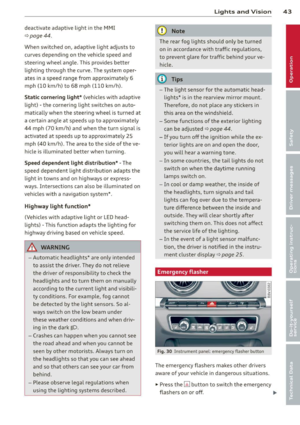 45
45 46
46 47
47 48
48 49
49 50
50 51
51 52
52 53
53 54
54 55
55 56
56 57
57 58
58 59
59 60
60 61
61 62
62 63
63 64
64 65
65 66
66 67
67 68
68 69
69 70
70 71
71 72
72 73
73 74
74 75
75 76
76 77
77 78
78 79
79 80
80 81
81 82
82 83
83 84
84 85
85 86
86 87
87 88
88 89
89 90
90 91
91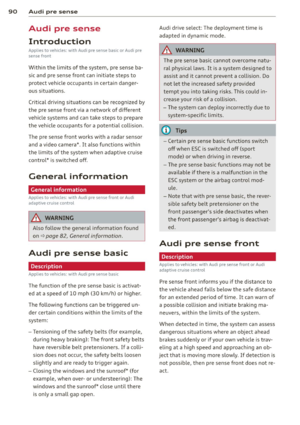 92
92 93
93 94
94 95
95 96
96 97
97 98
98 99
99 100
100 101
101 102
102 103
103 104
104 105
105 106
106 107
107 108
108 109
109 110
110 111
111 112
112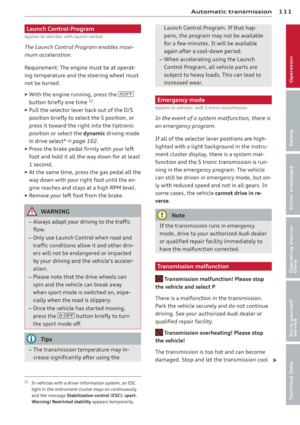 113
113 114
114 115
115 116
116 117
117 118
118 119
119 120
120 121
121 122
122 123
123 124
124 125
125 126
126 127
127 128
128 129
129 130
130 131
131 132
132 133
133 134
134 135
135 136
136 137
137 138
138 139
139 140
140 141
141 142
142 143
143 144
144 145
145 146
146 147
147 148
148 149
149 150
150 151
151 152
152 153
153 154
154 155
155 156
156 157
157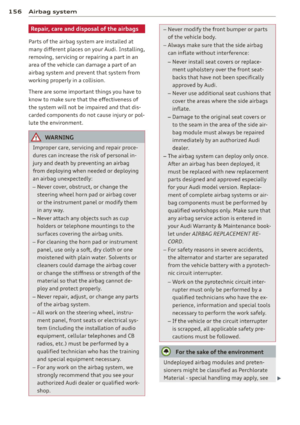 158
158 159
159 160
160 161
161 162
162 163
163 164
164 165
165 166
166 167
167 168
168 169
169 170
170 171
171 172
172 173
173 174
174 175
175 176
176 177
177 178
178 179
179 180
180 181
181 182
182 183
183 184
184 185
185 186
186 187
187 188
188 189
189 190
190 191
191 192
192 193
193 194
194 195
195 196
196 197
197 198
198 199
199 200
200 201
201 202
202 203
203 204
204 205
205 206
206 207
207 208
208 209
209 210
210 211
211 212
212 213
213 214
214 215
215 216
216 217
217 218
218 219
219 220
220 221
221 222
222 223
223 224
224 225
225 226
226 227
227 228
228 229
229 230
230 231
231 232
232 233
233 234
234 235
235 236
236 237
237 238
238 239
239 240
240 241
241 242
242 243
243 244
244 245
245 246
246 247
247 248
248 249
249 250
250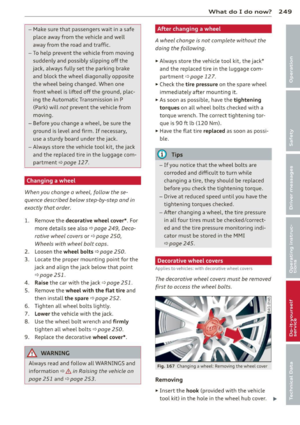 251
251 252
252 253
253 254
254 255
255 256
256 257
257 258
258 259
259 260
260 261
261 262
262 263
263 264
264 265
265 266
266 267
267 268
268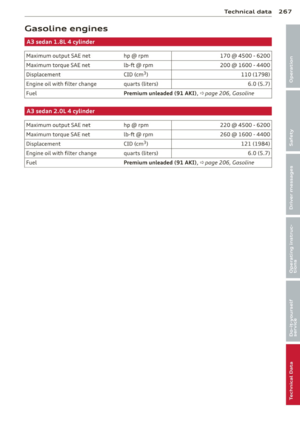 269
269 270
270 271
271 272
272 273
273 274
274 275
275 276
276 277
277 278
278 279
279 280
280 281
281 282
282 283
283 284
284 285
285 286
286 287
287






